
Here ye! Here ye! Welcome to the battle of the most loved geckos! Of course, we are kidding! But jokes aside, would it not be nice to know if leopard geckos are better than crested geckos? Are they really that different from each other?
Leopard and crested geckos are considered to be the best beginner-friendly geckos. One is not better than the other as it is based on preferences and the capability in providing their needs. In order to know which one is best for you, one should know their nature and how to take care of them.
With that said, we are going to talk about the major similarities and differences between leopard and crested geckos.
We will also talk about how to take care of them as well as the determining factors as to which gecko will suit you best (with a pros and cons list). We have a lot to cover, so read on!
Table of Contents
Why Leopard Geckos Are Not Better Than Crested Geckos
Leopard geckos are not better than crested geckos for the simple reason that both geckos cater to certain people. They may have similarities and differences, but at the end of the day, the value of a particular gecko is based on the intent of the future owner.
To illustrate, leopard geckos are the worse geckos if you want a more active gecko that you can see going around in its enclosure. You may also think that they are the worst geckos if you are disgusted by the fact that you need to feed them live insects.
If the things mentioned above are your purpose for getting a gecko, then, in that case, a crested gecko will be a better choice. So why are leopard geckos not better than crested geckos? It is because it depends on the owner.
In general, leopard geckos are highly suggested to be the gecko of choice for first-time owners. The selling point for such is that they are hardy geckos and are low maintenance compared to crested geckos.
On the other hand, crested geckos are well-loved for the simple fact that they are more open to handling and they look majestic while exploring the higher areas of their enclosure.
But some people are annoyed by the fact that crested geckos are so sensitive when it comes to humidity upkeep.
In order to find out which one is actually better for you, you need to know how their characteristics and maintenance will fit with your lifestyle and what you are looking for in a gecko.
Leopard Geckos vs. Crested Geckos
| Characteristics | Leopard Gecko | Crested Gecko |
| Size (adult) | 7-10 inches | 7-9 inches |
| Weight (adult) | 7-12.6 ounces | 10-11.5 ounces |
| Lifespan | 15-20 years | 10-20 years |
| Heating | 75-88 °F (day cycle) and 70-75 °F (night cycle) | 72-80 °F (day cycle) and 65-75 °F (night cycle) |
| Lighting | Low UVA and UVB lighting (2%-7%) | Low UVB lighting (5%) |
| Humidity | 30%-40% | 65%-85% |
| Socialization | Best to live alone except for breeding purposes, very territorial. Females often get along pretty well. | Keeps to themselves, can be territorial with same genders. Females often get along pretty well. |
| Temperament | Does not bite as much, vocal, can easily be trained to be handled | Docile, skittish, jumpy. Can still be handled, but with caution and proper training |
Now that you have a bigger picture as to what are leopard and crested geckos, let us now delve deep into their similarities and differences.
In this way, you can easily pinpoint if any of their qualities can fit your lifestyle and the level of care that you are prepared to do.
Similarities of Leopard And Crested Geckos
Needless to say, the leopard and crested geckos do not have a lot of similarities since they are geckos on both the opposite sides of the spectrum.
But the fact of the matter is, their similarities prove why they are both considered as the best beginner-friendly geckos.
Are Leopard Geckos Bigger Than Crested Geckos?
The average length of a leopard gecko is 8 inches. For larger leopard geckos, they can reach 10 inches! This is pretty much the same with the crested gecko as their average length is 7 to 9 inches.
So if you have an appropriately sized
For some leopard gecko owners, they want to bulk up their leos so that it can reach the maximum length of 10 inches in order to belong to the giant leopard gecko category.
One thing to note is that without external interference to manipulate their size, both the leopard gecko and the crested gecko will remain in their average size which is 8 inches.
This is perfect for those who would like to handle their geckos as an adult hand can more than accommodate the default size of both geckos.
When They Are Most Active
The leopard gecko is crepuscular. This means that it is most active late at night up to the wee hours of dawn. Some leo owners have observed that sometimes, their leos will go out at night and stay in a certain area in preparation for activities come dawn.
They only see their leos move about when there is that hint or peak of light from the sun.
On the other hand, crested geckos are generally crepuscular also, however, some researchers are slowly accepting the fact that they can also be nocturnal.
The reason for this is that they do also do activities at night. They already start looking for
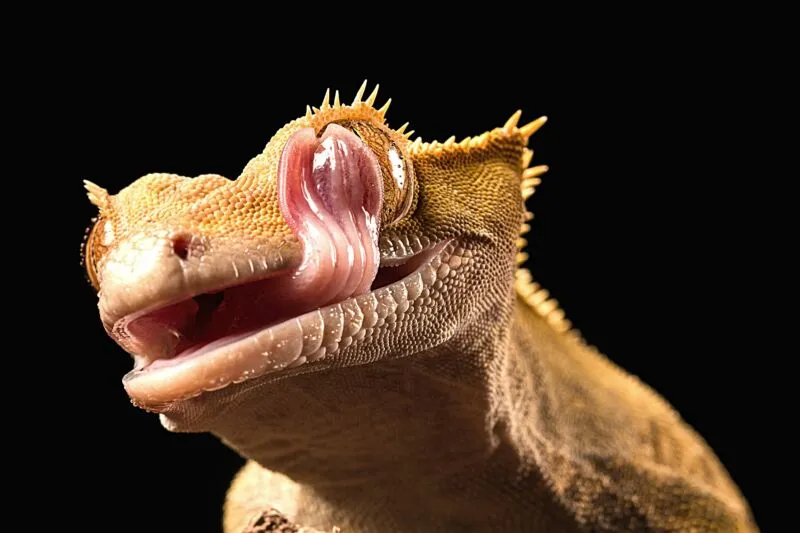
Further, in some studies, they were observed to hide once dawn comes around. Keep in mind that the majority of crested geckos are crepuscular. It is just that there were some that were observed to have a different cycle. Of course, this behavior is contrary to those who are crepuscular.
Are Leopard Geckos More Friendly Than Crested Geckos?
Both the leopard gecko and the crested gecko want to keep to themselves. They can handle a bit of socialization and handling, but that is about it. It is best to just view these geckos during their active time as opposed to taking them out whenever you want.
The good news is, both of them can be trained to be handled. In fact, people who have owned both leopard and crested geckos say that crested geckos although they are very jumpy, once they get the hang of handling, can stay put on your hand for a little while.
As for leos, it is like they are simply tolerating the time you handle them.
Bottom line is, they both prefer to live in their own world. At times, both of them can also be territorial. Therefore, you should first think twice when housing two male leopard or crested geckos in one enclosure.
Do Leopard Geckos Cost More Than Crested Geckos?
You might be considering getting the cheaper of the two, but in general, they go for similar prices. A regular morph of leopard and crested geckos are sold by reputable breeders within the $40-$60 range.
What might surprise you is that one can get them for even $1000 based on the rarity of the morph that you want.
A rare morph of the leopard gecko which is considered to be the rarest is called Black Night and people sometimes even pay up to $3000 to get their hands on this morph.
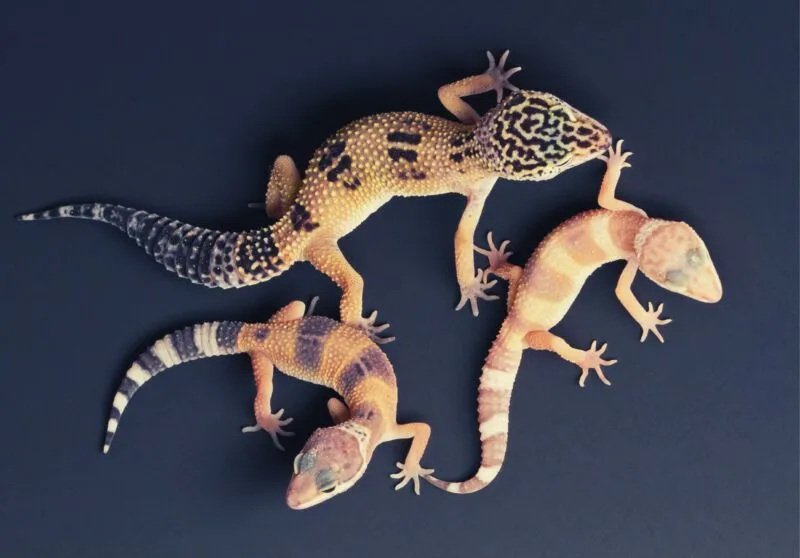
The same goes for crested geckos. One of the most sought-after morphs of crested geckos is Lavender. Yes, as the name suggests, the color has a tinge of light purple that does not change even though the crested gecko is flared up.
Depending on the reputation of the breeder, hard-to-find crested gecko morphs can also cost you $1000 and above.
In terms of how much you will spend for their upkeep, they pretty much balance each other out. From the get-go, you will spend more on a crested gecko as its enclosure is more expensive than that of a leopard gecko.
Further, you also need to buy certain instruments like a humidity thermometer and the like to properly maintain the conditions inside the enclosure.
Comparing this to the initial expenses of the leopard gecko, you will not burn your wallet from the beginning. However, you will incur extra expenses in maintaining and cultivating live feeders for your leo.
Additionally, you have to repurchase supplements that should be dusted on your feeders.
Add to that the medical examinations and checkups at the vet. So as you can see, you will spend the same amount of money for taking care of both the leopard and crested gecko.
Differences
As you might have noticed, there are not a lot of similarities, because as we said before, these two geckos are on the opposite sides of the spectrum.
They could not be even more black and white than they really are. You will find out what we are pointing at in this section.
Crested Geckos Need More Humidity Than Leopard Geckos
Both the leopard and crested gecko needs humidity. However, leopard geckos require less humidity compared to crested geckos. Take a look at the following:
Leopard Gecko Humidity Requirements:
- 30%-40% humidity
- No need for substrates that can maintain high humidity
- More emphasis on the high temperature in the enclosure compared to maintaining high humidity
Crested Gecko Humidity Requirements:
- 65%-85% humidity
- Light misting should be done to the dry areas in the enclosure once every night
- High emphasis on maintaining high humidity throughout the day
In a nutshell, leopard geckos prioritize high temperatures in the warm side of the enclosure. As for crested geckos, they need a slightly lower temperature in the warm side of the enclosure, but having high humidity is fundamental.
Why Is The Enclosure Of A Crested Gecko Expensive?
Both of the geckos require a 10-gallon enclosure in order to have space for everything. Still, 10-gallon tanks are the bear minimum. We highly recommend getting at least a 20-gallon tank.
However, the enclosure of the crested gecko should emphasize the height. As they are semi-arboreal, they need to climb on leaves and branches and that is simply their way of life.
They cannot thrive in an enclosure where they cannot roam around higher parts of the enclosure.
The bad news is that even though they are the same 10-gallon
Leopard geckos do not need a vertical enclosure. Just as long as they have a hide and other things in the enclosure for enrichment, they are good to go.
Of course, the warm and cool sides of the enclosure are also essential. But compared to that of the setup of the crested gecko enclosure, the leo’s enclosure is easier to accomplish and more straightforward.
Are Leopard Geckos Easier To Feed Than Crested Geckos?
Leopard geckos require you to feed them live, gut-loaded, and dusted insects. We used the term “require” because leos are very vocal when it comes to their
Food preparation is time-consuming for the owners as they need to gut load the insects 48 hours prior to feeding and they should also be dusted with supplements like Vitamin D.
On the other hand, crested geckos are very easy to feed. You can feed them commercially available crested gecko
Some owners also expressed their success in feeding soft baby
What Are The Major Physiological Differences Of Leopard And Crested Geckos?
Besides having different morphs and physiological characteristics (for example, spots, crests, and the like) let us discuss the two physiological factors that greatly differ between the two.
Tail Regrowth
We all know that most lizards can self-amputate their tails in a fight or flight situation. This is precisely the case for leopard geckos. They can lose their tails, but no need to worry as they will eventually grow back.
The bad news is for crested geckos as their tails do not grow back. Once they fall off, you are left with a tailless crested gecko for the rest of its life.
The good thing about this is that it rarely happens, except of course in drastic cases wherein the tail was squeezed, exposed to extreme trauma, etc.
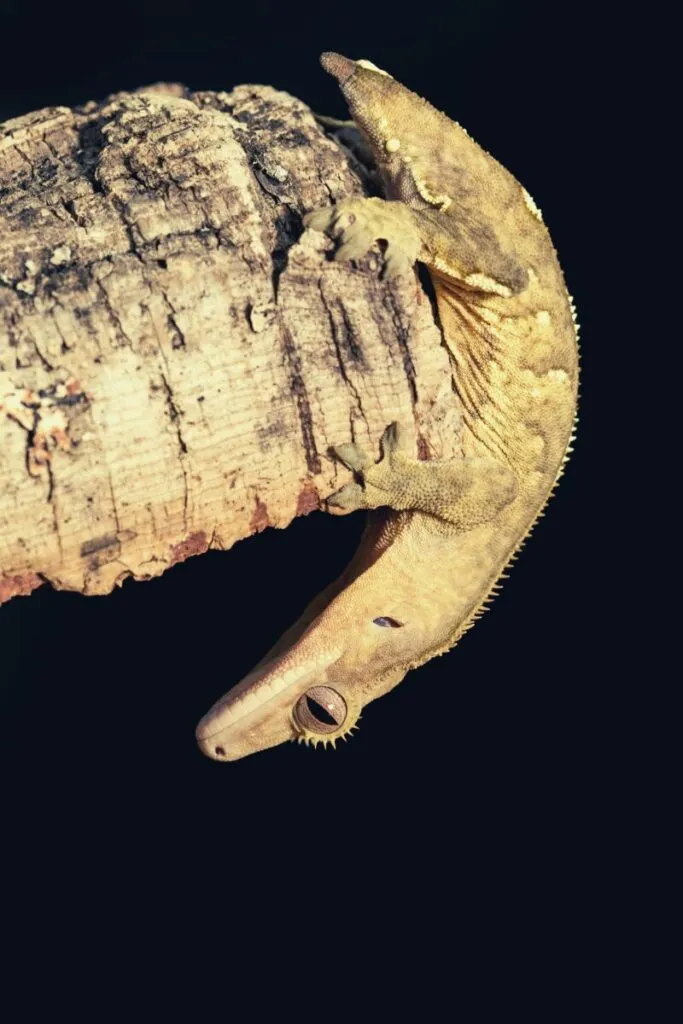
No need to fret if you got a tailless crested gecko because they can still thrive. Some activities may just be affected such as climbing and hunting
Toe Pads
In this department, the crested gecko is a bit special than the leopard gecko. This is the case as crested geckos have specialized toe pads. The reason for this is that they are semi-arboreal so they utilize these pads to hold them firmly on an inclined surface.
Leopard geckos do not have toe pads as they simply do not have a use for them. All they need to do with their toes is to help them in catching prey, help them get to the warm area to pseudo-bask, or help them walk on your hand. That’s it, very simple!
Which Gecko Suits You Best?
Now that you know the general similarities and differences between the leopard and crested gecko. It is now time for decision time! Are leopard geckos your cup of tea? Or will a crested gecko complete your life? Read the following to make a more informed decision.
The Leopard Gecko
Pros
- Has a lot of unique and interesting morphs
- Can easily be handled (using proper training and careful handling)
- Does not require a lot of enclosure maintenance
- Can somewhat communicate their feelings via their tail movements
- Easier to maintain humidity
- Enclosure tends to be cheaper
- Tends to be hardy
Cons
- Can be too vocal especially come feeding time or when they are hungry
- The males are territorial not only to fellow leos but other species as well
- Spot cleaning should be done once a day to remove uneaten
food that might harm them - Food preparation is tedious and may be too much for those who are not used to live feeding
- Prone to metabolic bone disease
- A bit tricky to calibrate heating requirements
The Leopard Gecko Is For You If…
The leopard gecko is perfect for you if this is your first time getting a gecko. This is because they are very hardy and the calibration of their heating and feeding needs is pretty much low maintenance.
You do not have to check the temperature by the hour just to make sure that you have everything done right.
However, if you are iffy about feeding live insects, then the leopard gecko is not for you as they demand to be fed live feeders.
Further, if you have spare time to just sit and observe a gecko, then it is a good fit because more often than not, you have to keep on looking at your leo for signs of Metabolic Bone Disease as it is a common occurrence (it can be easily avoided though).
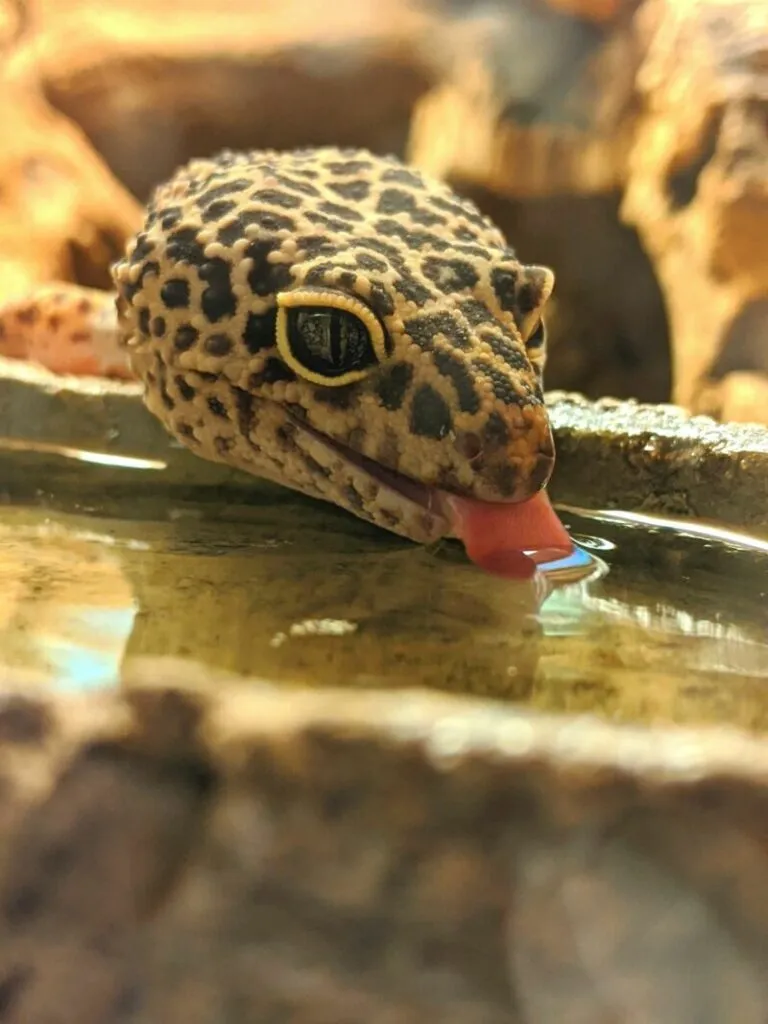
If you are more interested in desert terrariums, then it is best to go with leopard geckos as that is their natural habitat. Moreover, if you are planning to give a child a leopard gecko, it is best for 12 years old and above.
The reason being, even though they are a hardy species, one still needs to fully understand proper heating and feeding protocols that kids at a younger age may not understand.
Further, it is not best to get a leopard gecko if you want to view them and handle them whenever you want. In this case, you have to wait for the wee hours of the evening to see them in action.
For those who are patient enough to wait, you might be even rewarded with that cute smile they are known for.
The Crested Gecko
Pros
- Has a lot of eye-catching patterns and morphs
- Has a docile temperament, they rarely bite even if they have to (no pain included too!)
- Great to watch especially when they are climbing about
- Easy to procure
- Does not require to be fed live insects
- Heating requirements are easy to maintain
Cons
- Their tails do not regrow (but we still love them anyway!)
- Territorial males, you cannot house them together
- Can easily get stressed in faulty temperatures
- Can easily get mouth rot and other respiratory infections
- Requires high maintenance in terms of humidity, constant misting is essential
- The enclosure is more expensive
- Not that hardy compared to leopard geckos
The Crested Gecko Is For You If…
The crested gecko is perfect for you if you are a beginner reptile owner but you want to learn the ins and outs of lizard or reptile keeping.
It is still considered a low-maintenance gecko, however, you really have to go through the learning phase of calibrating the temperature and humidity requirements. With that said, if you are a first-time gecko owner, the crested gecko may not be for you.
This does not mean that your crested gecko will end up struggling for its life if you slightly mess something up. No, this is not the case.
We just mean that there are many daily checks and adjustments needed to be done in their enclosure compared to leopard geckos.
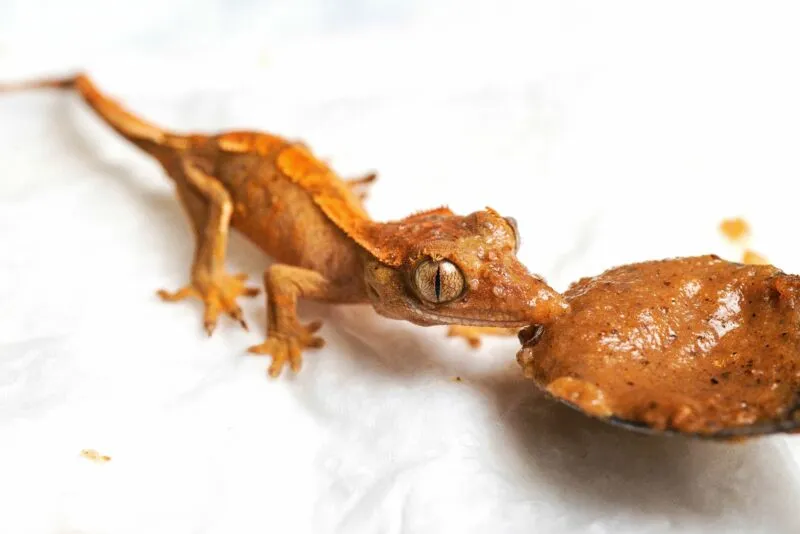
If you have the patience to truly get the essence of maintaining proper humidity and heating levels, then a crested gecko will be great for you.
Given this information, it is not best for children as they cannot properly maintain the setup requirements all by themselves.
You will love owning a crested gecko if you want to view them while they do their regular activities. They are a bit more active than the leopard gecko so you will most likely see them climbing about in their
Lastly, if at the end of the day you just want a gecko that you can handle often, then a crested gecko is more likely to be the answer to that.
Final Words
So are you team leopard gecko? Or team crested gecko? Which one is really the best? Well, for the best beginner-friendly gecko, they sure are both winners!
But if we may add some distinctions, we think that when it comes to easy maintenance and being a hardy gecko in general, the leopard gecko is your best bet.
The crested gecko is perfect for those who would want to handle their geckos more often than usual (if you are willing to wait until the sun sets) If you are planning to delve deep into hardcore reptile care and you want to start somewhere, go for this lovable gecko.
If you have some time to spare and would want more information regarding the differences between these two awesome geckos, you can watch the video below.
- Eastern Rat Snake: Nature’s Pest Control and Fascinating Reptile - September 20, 2024
- Eastern Racer: The Fast and Agile Snake - September 19, 2024
- The Eastern Indigo Snake: The Majestic, Non-Venomous Hunter of the Southeast - September 18, 2024
